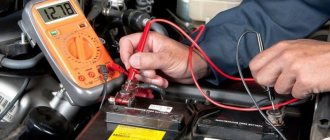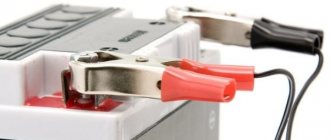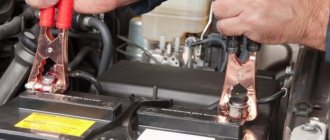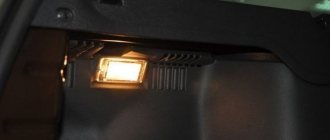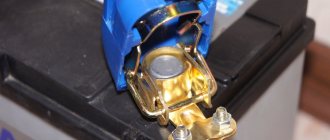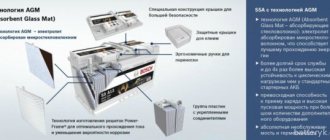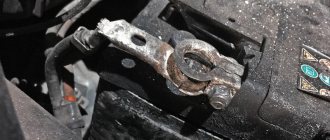In what cases will it be possible to light a car?
- You can “light” the car if it does not start due to a low battery. For example, if the starter turns poorly or does not turn at all during the first attempt to start. This can happen due to long-term parking of the car;
- If the battery is dead due to lack of charging in the car and a faulty generator;
- If the dead battery is in good working order and able to accept a charge. Typically, when a battery is deeply discharged, it may lose its capacity. For example, if you leave a working battery in a discharged state for half a year, then you can most likely forget about its further use;
- The starting wires for lighting have a good cross-section and are made of quality materials;
- The capacities of the donor battery and the car being lit must be at the same level (or the capacity of the former should be higher). You shouldn’t try to start a truck from a subcompact car—nothing good will come of it;
- The operating voltages of the vehicles' on-board network are the same. You should not try to light a car with an on-board voltage of 24 Volts from a 12 Volt power source.
Which wires are better for lighting?
Let us highlight several brands that are distinguished by consistently high quality products:
- AVS and AIRLINE (China);
- Heyner and Alca (Germany);
- Lampa (Italy);
- Phoenix and Autoelectrics (Russia).
But even their cables cannot be called ideal. And, nevertheless, in terms of price and quality ratio they are market leaders. It is noteworthy that Russian products are superior in a number of parameters to products from German and Italian manufacturers and at the same time have a much lower cost.
Here is the anti-rating of cables that are best avoided:
- ", NPP "ORION" (Russia);
- King Tools, Smart Power Berkut, Nova Bright, Tiikeri (China);
- AkkuEnergy, Heyner (Germany).
During tests, they showed the maximum voltage drop, and some even refused to work due to loss of contact in the very first seconds of startup. When purchasing a jump starter cable, be sure to inquire about the warranty and ask for a receipt. If the product turns out to be of poor quality, you can return it back within the time limits established by law.
Selecting jump leads
At first glance, the question is trivial, but you should also devote a little time to it. Starting wires can be purchased if:
- They have a large cross-section of wires, the larger the better, the material is copper;
- Crocodiles have powerful springs and are well soldered or crimped to the wires;
- The length of the wires should be selected specifically for your car; you should not buy wires that are too long.
Jump wires
Wires should be purchased not only in case of a dead battery, but also “for the future,” since usually the driver does not expect his battery to die. It will be very useful to find “lighting wires” in your trunk in this case. Usually the cost of starting wires does not exceed 1,300 rubles; if they sell you more expensive wires, then you should go to the store “opposite”.
Reviews
Above we have given only a “drop in the bucket” of all the portable batteries offered in stores today. In fact, there are many more of them, but they all have approximately the same functionality. When studying reviews of portable batteries on the Internet, we noticed that most of them do not even come from car owners, but from students and travelers who do not buy them to start a car engine. In particular, tourists are interested in charging numerous devices on the road and in recreational areas where there are problems with connecting to the power grid. Feedback from students indicates that portable batteries are excellent for recharging the power of laptops and tablets that they carry to lectures. Judging by the reviews, everyone was satisfied with the large number of adapters in such portable batteries. As for the reviews from car owners, they are generally positive. For many car owners, portable batteries have come to the rescue on the road during an emergency engine start. And charging “gadgets” is not an idle issue for drivers setting off on a long journey. Among the negative aspects of portable batteries, all user groups noted the low nominal capacity of the devices. Less often you can find reviews about capacity that does not correspond to the declared one. Have you tried using portable batteries? If yes, then we are waiting for your feedback in the comments. Vote in the poll and rate the article!
How to light a car correctly
So, you have a “donor” - a car that will share its energy with your car, starting wires and the car itself with a dead battery. To ensure that this procedure does not turn out badly for all participants in this procedure, I advise you to follow the following instructions:
- Park the donor so that access to both batteries in the vehicle is open and convenient. If the donor is not warmed up, then I advise you to at least warm up the car a little so that its battery is fully charged. Turn off the car, turning off all current consumers;
- For a dead vehicle, all energy consumers, including the ignition, should also be turned off;
- The wires should be connected as follows (see diagram below): first connect the red crocodiles of the wires to the battery positives. First connect the “plus” to the discharged power source, and then connect to the donor. Fix the negative black wire to the battery of the donor car, and attach the second edge of the wire to the metal part of the engine (it is advisable to use a place in close proximity to the generator or starter). Many people connect this wire to the negative terminal, but I do not recommend doing this;
Wiring diagram
- Check the wire contact and correct connection . The contact must be good, the polarity must be observed! To do this, it is necessary that the crocodiles of the wires be pressed as tightly as possible to the points of contact. If any crocodile makes poor contact, you will not be able to start the car;
- Start the donor car and let it run at medium speed so that its generator can slightly recharge the dead battery. Usually it takes 15 minutes. This time is enough for a dead battery to gain the necessary capacity to start the internal combustion engine;
- Turn off the donor engine and try to start the car with a dead battery. If the wire contact is good and the dead battery is in good condition, the car will start without problems . If the car does not start, correct the wires and repeat the previous steps again;
- After successfully starting the car, let the car run for 10 minutes, then you can disconnect the wires. You need to start with the black crocodile on a running car, then disconnect the red crocodile on it, and then remove the wires from the donor battery. Be careful not to short-circuit the wires while they are connected to the donor battery.
If you were unable to start the car with a dead battery in this way, I recommend removing the battery and charging it properly. Do not risk “lighting” the car with the engine running. Such an action can damage some of the electronic components of the car; this can be caused by large voltage surges at the time of starting the internal combustion engine.
Subscribe to our YandexZen
3+
671
Power crocodiles for a car starting device: what's inside and can they do it?
I welcome everyone who stopped by. The review will focus, as you probably already guessed, on power crocodiles for car jump starters, which allow you to start the engine even with a dead on-board battery. The device is very interesting and necessary, especially for me, but it often comes with very mediocre crocodiles. If you are wondering whether they can be used for their intended purpose, you are welcome...
Package:
Power crocodiles are delivered in a simple postal bag, wrapped in a plastic pocket and, if I’m not mistaken, additionally wrapped in a bubble wrap:
They arrived safe and sound, Russian Post was unable to break them.
Appearance:
Power crocodiles are practically no different from their counterparts, which are sold separately or supplied complete with a starting device (automatic starter, also known as a jump starter) for the car:
The sizes are standard, as an example comparison with a thousand dollar bill and a box of matches:
In order not to confuse the polarity when connecting, the terminals and wires used differ in color. The power connector is the usual EC5, designed for a continuous current of 120A:
The workmanship is good, the sleeves are recessed relative to the body, and there are special notches at the end that make it easier to remove from the connector:
It was not in vain that I mentioned the quality, because here it differs by an order of magnitude for the better compared to some complete alligator clips and most separately sold connectors. The advantage is that the sleeves are brass and are absolutely not magnetic, unlike the previously mentioned ones:
These crocodiles were purchased for use on another project that also required mechanical short circuit protection. To be extremely simple, crocodiles with plastic sides were required that would prevent accidental contact of the current-carrying parts of the crocodile sponges themselves:
They fully comply with the stated requirements, have a stiff spring (“the finger does not tolerate”) and tooth-shaped current collectors (jaws) that reliably “bite” into the battery terminals:
The sizes of crocodiles are average, the maximum “spread” of the teeth is about 3.5 cm:
Now about the unpleasant moments. The material of the jaws is most likely not copper, but copper-plated steel about 1.2 mm thick, i.e. a stamped steel plate galvanically coated with a thin layer of copper. As expected, the jaws are magnetic:
I’ll be honest, this option is used almost everywhere, so when purchasing such devices, keep this in mind and don’t be surprised.
The second jamb of the Chinese, which is also present in almost all such crocodiles, is connecting only one current collector. The second one is present for more reliable clamping and is not connected in any way:
The power wire is not soldered/welded, but simply pressed in, which means that over time it will oxidize, there will be poor contact and additional losses:
Although it is worth noting that it is compressed “conscientiously”:
The cross-section of the power wire is 10AWG, which in our terms means about 5.3 sq.mm:
Such wires can easily carry a current of 70A without significant heating. I’ll add on my own that the wires are similar to the silicone-insulated stranded wires I previously reviewed, the quality of which I really liked. I reviewed them earlier.
The protective block is the simplest - based on four dual Schottky diodes STPS2045CT:
Its purpose is to prevent the battery in the car (patient) from trying to charge the battery in the starter, and after starting the car engine, so that the generator does not try to charge the starter (donor). In other words, after starting the engine, the generator starts working, which has a higher output voltage (usually 14.4V) and, therefore, begins to recharge the on-board lead battery and power other consumers. According to the laws of physics, the one with the highest voltage always gives back. And if there were no protective diodes, then the generator would begin to charge the starting device (automatic starter), which is very, very undesirable.
The peculiarity of diodes is that they always pass current in only one direction, but like all elements, they have a certain resistance and, depending on the current passing through them, heat up. Schottky diodes, which differ from conventional diodes in their low voltage drop, allow losses to be minimized. When starting the engine, the voltage on them sags less, and the more that reaches the patient, the better. In this case, four dual diodes are installed, 20A each:
Since in a parallel connection the current spreads over the shoulders, the more diodes, the better. This is where the biggest drawback of these crocodiles is - the protective block in them is designed for a rated current of 80A, but when starting a cold engine, the currents can reach up to 250-280A. My Vinsun V5 starter had 4 dual 40A diodes (42CTQ030S) and easily passed 160A (before modification). I used them for a couple of years and made about 30 starts, including a dozen pretty hard ones in severe frosts. I have previously given my measurements, in which the starter needed 150A to start a cooled 1.6 liter engine (100 hp), 220-250A in cold weather. The crocodiles in question will most likely not survive and will either burn out or melt away. They are only suitable for helping to start a car engine in mild frosts or when the battery is not very low.
But again, the “base” itself of the monitored crocodiles is much better. The diodes are soldered to a copper (brass) plate and transfer heat well to it, but the wires are simply soldered and not crimped in any way:
There is also an option using power mosfets, but it is more expensive and is practically not found in such cheap options.
Conclusions:
The crocodiles are really quite good, in particular, the “base” is an order of magnitude better than the usual ones. These include honest brass connector sleeves and a more competent implementation of the protective block, where the diodes are soldered to a brass plate, and not to a printed circuit board. Unfortunately, there are also typical “jambs”: copper-plated jaws, one of which is not connected, less powerful Schottky diodes and a mediocre implementation of connecting the wire to the protective module.
What in fact. If your hands are growing from the wrong place and you need help starting up mainly in cold weather, it’s better to look at something else, because they may let you down. If you monitor the condition of the battery and do not allow strong discharges, or your hands grow out of place, then they will do, but with a little modification you will get good “unkillable” crocodiles for years.
If the topic is interesting, I can make a short review on improving my crocodiles, fortunately I still have photos. Like, repost and whatever else :-)))
The crocodiles in question were apparently purchased here
Now they sell an improved version with a more convenient connector.
Good Schottky diodes (42CTQ030S) 40A each here
Power crocodiles for 100A separately here
